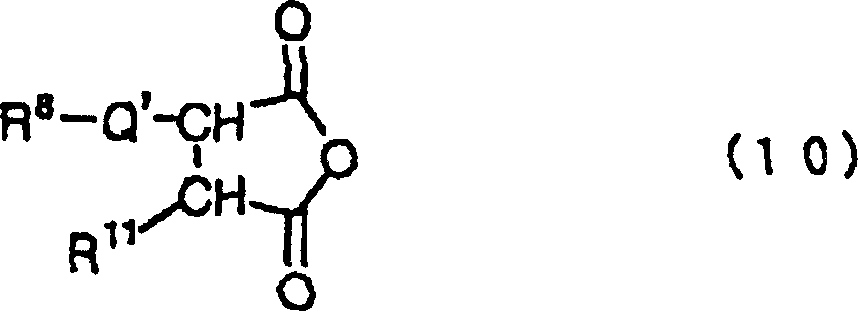Block polymer and antistatic agent comprising the same
A technology of block polymers and hydrophilic polymers, applied in the field of antistatic agents, can solve problems such as mold pollution, reduction of resin mechanical strength and moldability, and insufficient compatibility
- Summary
- Abstract
- Description
- Claims
- Application Information
AI Technical Summary
Problems solved by technology
Method used
Image
Examples
preparation example Construction
[0338] As for the preparation method of the block polymer (A2), there can be mentioned a method including reacting (a4)-(a6) with (b2), and including, for example, the presence of (a4) in the process of preparing (b2) The following is a method of reacting the precursor (reactant) of (b2) to simultaneously form the block of the polymer (b2) and the block polymer (A2).
[0339] In the case where (b2) is the polyether ester amide (b2-1), its preparation method is not particularly limited, but includes the following methods.
[0340] Those block polymers (A2) in which (b2) are polymer segments other than polyether ester amide (b2-1) can be prepared in the same manner.
[0341] Method 1: A method including polymerization reaction of (a4-1) represented by general formula (9) and polyether ester amide (b2-1) at 200-250°C under reduced pressure.
[0342] Method 2: A method including polymerization reaction of (a4-1), (Q1) and (b1-1) at 200-250°C under reduced pressure.
[0343] Method 3: ...
preparation Embodiment 1
[0470] Under nitrogen, 85 parts of low-molecular-weight polypropylene having an Mn value of 2,500 and a density of 0.89 obtained by the thermal degradation method was melted with 15 parts of maleic anhydride at 200° C. and reacted for 20 hours.
[0471] Then, excess maleic anhydride was distilled off under reduced pressure to obtain acid-modified polypropylene (a1-1①).
[0472] The acid value of (a1-1①) is 39.8, and the Mn value is 2,800.
preparation Embodiment 2
[0474]At 160℃, the low molecular weight polypropylene (80 parts) with Mn value of 2,500 and density of 0.89 obtained by thermal degradation method was melted together, and then 7 parts of maleic anhydride and 14 parts of 12-aminododecanoic acid were added. The reaction was carried out at 160°C for 1 hour under nitrogen.
[0475] The reaction was continued for another 20 hours at 200°C to obtain acid-modified polypropylene (a1-1②).
[0476] The acid value of (a1-1②) is 32.1, and the Mn value is 2,800.
PUM
| Property | Measurement | Unit |
|---|---|---|
| electrical resistivity | aaaaa | aaaaa |
| acid value | aaaaa | aaaaa |
| electrical resistivity | aaaaa | aaaaa |
Abstract
Description
Claims
Application Information
 Login to View More
Login to View More - Generate Ideas
- Intellectual Property
- Life Sciences
- Materials
- Tech Scout
- Unparalleled Data Quality
- Higher Quality Content
- 60% Fewer Hallucinations
Browse by: Latest US Patents, China's latest patents, Technical Efficacy Thesaurus, Application Domain, Technology Topic, Popular Technical Reports.
© 2025 PatSnap. All rights reserved.Legal|Privacy policy|Modern Slavery Act Transparency Statement|Sitemap|About US| Contact US: help@patsnap.com



